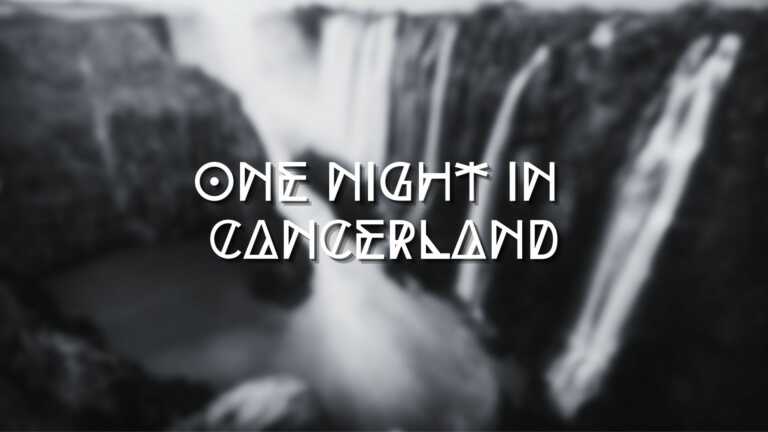Within the confines of the small examination room, Shannon and I nervously await the arrival of my oncologist.
Although there’s always plenty riding on an oncology appointment, this one is different. I’ll be learning more about my treatment options since being diagnosed with advanced cancer two weeks prior.
I’m aware of the details of my recurrence: multiple, inoperable lesions peppered throughout each segment of my liver. Each varying in size, indicating that they may have been passengers for much longer. Perhaps even from the beginning of my treatment in March of 2022.
It doesn’t change anything. In cancerland, if it’s too small to see, then it’s too small to treat.
In a way, it’s almost good that they made an appearance when they did. Surveillance picked it up now instead of six months from now.
At least the work can begin.
Bushwhacking
My oncologist enters the room.
She’s a slender woman of medium height with long brown hair and an empathetic—yet authoritative—voice. I’ve not seen the face beneath her hospital mask, but I’m imagining a welcoming smile.
Her confidence and humanity is reassuring. I trust her with my life.
“Hi, Jason. Hi, Shannon,” she says, taking a seat on what looks like the most uncomfortable stool the hospital could find.
We exchange pleasantries as I re-check the notes I have on my phone. It’s a paranoia check to ensure that I remember all of the questions I want to have answered:
- Is there any benefit to picking back up with systemic treatment while I wait for my surgical appointments and next steps from those?
- Do we have the information back from my extended genetic testing to see if I’m a candidate for targeted therapies?
- Is it reasonable to aim for cure, or are we into palliative treatment now?
I’ve had weeks to think about these. I don’t know why I think I’d all of a sudden forget.
Tactfully, my oncologist navigates mention of upcoming appointments I have with two different hepatobiliary specialists (liver, gallbladder, and bile specialists) over the coming weeks.
“Does Shannon… is she…?,” the doctor hesitates, considering that I may have left Shannon out of the loop.
“Shannon knows everything about the appointments and what’s going on,” I reply, “and I want her to know everything that I know.”
The conversation flows more naturally from there.
No secrets. No lies of omission. No politicking about my health and prognosis.
No passing the buck to my doctor to share complicated news.
I forget, in that moment, how many people don’t share the intimate details of their diagnosis or prognosis with their partner. This is something I take for granted with Shannon: we communicate well. For better or worse, she knows everything.
“So, we’re in a new world now,” my doctor begins, “and we’re walking a fine line between curative and palliative treatment. We’ve never done this before.”
Cure is still the intent, but there’s a very roundabout way to get there. I’m undergoing palliative treatment, but if it works well enough, then cure is a possibility.
At a high level, she reviews the working plan that my team of specialists have agreed is the best path forward:
- We’re going to attempt to stop the spread and stabilize my cancer
- I’ll move to surveillance scans every three months, with bloodwork every other week
- The goal is to beat back the cancer enough that I’m a candidate for a liver transplant
- Failing that, there’s also the chance that the lesions could shrink and my liver could become operable
A large number of things need to go right for this plan to work. It’s a longshot, but it’s a path forward nonetheless. Transplant as Plan A is terrifying for more reasons than I can explain. I have a mental note to ask the liver specialists about an implanted chemotherapy pump, which hasn’t been mentioned as an option.
She goes on to describe how we’re going to pick back up on systemic chemotherapy for six months. The aim is to shrink or stabilize the growth of cancer in my liver and to prevent it from spreading elsewhere in my body.
We discuss adding a targeted therapy—a monoclonal antibody—once the results of some extended genetic testing come back.
I’ll be starting on FOLFIRI. It’s a different regimen than I was on before, swapping out the Oxaliplatin that caused me so much grief with a drug called Irinotecan that will cause different grievances.
Would you rather: lose your hair and never trust a fart again OR experience peripheral neuropathy and cold sensitivity together?
This cycle will be identical to the one that I had last time: infusion at the hospital every other week, with a take-home infusion pump for 46 hours.
“When do I start?,” I ask.
It makes me feel nauseated just thinking about being back in the infusion chair.
“Immediately,” she replies, “we’ll start Thursday. We can add in the biologic from the second cycle onward.”
My mind immediately jumps to the worst parts of chemotherapy. The perpetual fatigue. The brain fog. Somehow feeling simultaneously dehydrated and hydrophobic. Lugging around an infuser pump.
The stagnant hospital air. Chairmates blaring CNN and FOX News in what is either a competition or an indication of their deafness.
Fuck. I’m not ready to throw in the towel, but I really don’t want to have to do this.
Collectively, we talk through the different side effects of the new treatments. This is not without its own risks.
Chemotherapy is, after all, attempting to control cell reproduction. Healthy cells are destroyed in this process, too.
Cancer treatment itself increases a person’s susceptibility to other cancers. There’s also diarrhea. Hair loss. Skin rashes. Hand and foot syndrome. Mouth sores. Neutropenic fever. The list goes on.
I’m handed a consent form to read and sign.
Sign here to keep living. Or don’t. You can always just go home and count the months, instead.
I sign the form to finish up the appointment.
It ends the way they always do: “Someone will be in touch.”
Maslow strikes
Shannon and I leave the appointment and head to the grocery store.
We’ve decided that, since it’s lunchtime, we should pick up some deli meats, fresh bread, and some fancy cheese. We take the opportunity to pick up some nice steaks for dinner.
We discuss the appointment on the drive over and agree that there is nothing surprising about the information we received.
It doesn’t matter what else is going on: you still have to eat.
We head home, have lunch, and make a few calls to share the plan and next steps with some family and friends.
I log onto my work chat and let my bosses know that I’ve set a meeting for Tuesday to talk about my leave of absence.
I’m very worried about loss of income and ability to work. Shit. What if I can never work again? It’s a lot to think about.
Then, a nap.
Because fuck this day.
…but that’s interrupted by a call from Community Care booking my infuser disconnect for the following weekend.
Sometimes self-care is just laying in bed, having a nap, and letting the cats pile on top of you. It’s annoying when that’s interrupted, but I’m back to a place where I can’t ignore a ringing phone.
I haven’t even restarted treatment and it’s already time to start project managing my cancer.
If you’re going through hell, keep going.
Unattributed
What if this doesn’t work?
Onward.
Upward.
Never backwards.
What if it does?
Only time will tell.








